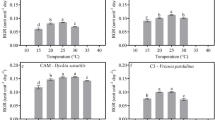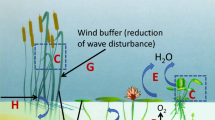Summary
The Eurasian watermilfoil (Myriophyllum spicatum L.) has partially replaced wild celery (Vallisneria americana Michx.) as a community dominant in the littoral zones of lakes of Madison, Wisconsin. The two species have very different growth forms, with that of M. spicatum corresponding more closely to the optimal growth form simulated by the macrophyte production model WEED. The objective of this research was to investigate the mechanisms by which Vallisneria could compensate for its nonoptimal growth form and coexist with Myriophyllum.
A quantification of midsummer growth form for the two species at a rooting depth of 80–90 cm showed that M. spicatum had 68% of its shoot biomass within 30 cm of the surface, whereas V. americana had 62% of its leaf biomass within 30 cm of the bottom. Vallisneria had a light extinction coefficient ranging from 0.013 to 0.019 m2·g-1, much higher than the value (ca. 0.006 m2·g-1) for M. spicatum. This indicates less effective penetration of light to lower leaves of V. americana. Half-saturation constants describing the light-dependence of carbon uptake in “shade” and “sun” tissues ranged from 60–197 microeinsteins·m-2·s-1 for V. americana, and 164–365 μeinsteins·m-2·s-1 for M. spicatum. The optimum temperature for photosynthesis was 33.6°C for M. spicatum and 32.6°C for V. americana, but Myriophyllum was nearly twice as effective at carbon uptake at 10°C. Integration of all of the above features with WEED showed that, for midsummer conditions, V. americana more than compensated for apparently disadvantageous morphological features by its greater physiological adaptability to low light regimes. Coupled with the temperature-dependence of photosynthesis, it appears that V. americana is favored by midsummer conditions, whereas M. spicatum is at an advantage at other times.
Similar content being viewed by others
References
Antonovics, J.: The nature of limits to natural selection. Ann. Miss. Bot. Gard. 63, 224–247 (1976)
Bradshaw, A.D.: Evolutionary significance of phenotypic plasticity in plants. Adv. Genetics 13, 115–155 (1965)
Bratton, S.P.: Resource division in an understory herb community: responses to temporal and microtopographic gradients. Amer. Natur. 110, 679–693 (1976)
Chesnut, T.L., Barman, E.H. Jr.: Aquatic vascular plants of Lake Apopka, Florida. Florida Scientist 37, 61–64 (1974)
Curtis, J.T.: The vegetation of Wisconsin. University of Wisconsin, Madison, Wisconsin, 657 pp. 1959
Denniston, R.H.: A survey of the larger aquatic plants of Lake Mendota. Trans. Wis. Acad. Sci. Arts Lett. 20, 495–500 (1921)
Denny, P.: Lakes of south-western Uganda. II. Vegetation studies in Lake Bunyonyi. Freshwater Biol. 3, 123–135 (1972)
Duncan, W.G., Loomis, R.S., Williams, W.A., Hanau, R.: A model for simulating photosynthesis in plant communities. Hilgardia 38, 181–205 (1967)
Fassett, N.C.: The plants of some northeastern Wisconsin lakes. Trans. Wis. Acad. Sci. Arts Lett. 25, 157–168 (1930)
Fassett, N.C.: A manual of aquatic plants. University of Wisconsin Press, Madison, Wisconsin. 405 pp. 1957
Gessner, F.: Die Beziehung zwischen Lichtintensität und Assimilation bei submersen Wasserpflanzen. Jahrb. Wiss. Bot. 86, 491–526 (1938)
Harman, W.N., Doane, T.R.: Changes in the aquatic flora of Otsego Lake, New York, between 1935 and 1969. N.Y. Fish Game J. 17, 121–123 (1970)
Ikusima, I.: Ecological studies on the productivity of aquatic plant communities. 2. Seasonal changes in standing crop and productivity of a natural submerged community of Vallisneria denseserrulata. Bot. Mag. Tokyo 79, 7–19 (1966)
Lind, C.T., Cottam, G.: The submerged aquatics of University Bay: a study in eutrophication. Amer. Midl. Natur. 81, 353–369 (1969)
Manning, W.M., Juday, C., Wolf, M.: Photosynthesis of aquatic plants at different depths in Trout Lake, Wisconsin. Trans. Wis. Acad. Sci. Arts Lett. 31, 377–410 (1938)
Marker, A.F.H., Westlake, D.F.: Primary Production — Introduction. In: International Biological Programme, The functioning of freshwater ecosystems. E.D. LeCren (ed.). Cambridge: University Press
Meyer, B.S., Heritage, A.C.: Effect of turbidity and depth of immersion on apparent photosynthesis in Ceratophyllum demersum. Ecology 22, 17–22 (1941)
Meyer, B.S., Bell, F.H., Thompson, L.C., Clay, E.I.: Effect of depth of immersion on apparent photosynthesis in submersed vascular aquatics. Ecology 24, 393–399 (1943)
Mooney, H.A.: The carbon balance of plants. Ann. Rev. Ecol. Syst. 3, 315–346 (1972)
Nichols, S.A., Mori, S.: The littoral macrophyte vegetation of Lake Wingra. An example of a Myriophyllum spicatum invasion in a southern Wisconsin lake. Trans. Wis. Acad. Sci. Arts Lett. 59, 107–119 (1971)
Oglesby, R.T., Vogel, A., Peverly, J.H., Johnson, R.: Changes in submerged plants at the south end of Cayuga Lake following tropical storm Agnes. Hydrobiologia 48, 251–255 (1976)
Owens, M., Learner, M.A., Maris, P.J.: Determination of the biomass of aquatic plants using an optical method. J. Ecol. 55, 671–676 (1967)
Ruttner, F.: Über die Kohlensäureassimilation einiger Wasserpflanzen in verschiedenen Tiefen des Lunzer Untersees. Int. Rev. ges. Hydrobiol. 15, 1–30 (1926)
Schomer, H.A.: Photosynthesis of water plants at various depths in the lakes of northeastern Wisconsin. Ecology 15, 217–218 (1934)
Sculthorpe, C.D.: The biology of aquatic vascular plants. Edward Arnold Publishers, London. 610 pp. 1967
Shugart, H.H., Goldstein, R.A., O'Neill, R.V., Mankin, J.B.: TEEM: a terrestrial ecosystem energy model for forests. Oecol. Plant. 9, 231–264 (1974)
Spence, D.H.N., Chrystal, J.: Photosynthesis and zonation of freshwater macrophytes. I. Depth distribution and shade tolerance. New Phytol. 69, 205–215 (1970a)
Spence, D.H.N., Chrystal, J.: Photosynthesis and zonation of fresh-water macrophytes. II. Adaptability of species of deep and shallow water. New Phytol. 69, 217–227 (1970b)
Stanley, R.A., Naylor, A.W.: Photosynthesis in Eurasian watermilfoil (Myriophyllum spicatum L.). Plant Physiol. 50, 149–151 (1972)
Stewart, K.M., Hasler, A.D.: Limnology of some Madison lakes: annual cycles. Trans. Wis. Acad. Arts Lett. 60, 87–123 (1972)
Stuckey, R.L.: Changes of vascular aquatic flowering plants during 70 years in Put-In-Bay Harbor, Lake Erie, Ohio. Ohio J. Sci. 71, 321–342 (1971)
Taylor, R.J., Pearcy, R.W.: Seasonal patterns of the carbon dioxide exchange characteristics of understory plants from a deciduous forest. Can. J. Bot. 54, 1094–1103 (1976)
Thomas, A.G., Dale, H.N.: Cohabitation of three Hieracium species in relation to the spatial heterogeneity in an old pasture. Can. J. Bot. 54, 2517–2529 (1976)
Titus, J.E.: Depth relations of photosynthesis and a production model for Myriophyllum spicatum L. M.S. Thesis, University of Wisconsin, Madison, Wisconsin, 80 pp. 1973
Titus, J.E.: The comparative physiological ecology of three submersed macrophytes. Ph.D. Thesis, University of Wisconsin, Madison, Wisconsin. 195 pp. 1977
Titus, J.E., Adams, M.S.: Comparative carbohydrate storage and utilization patterns in the submersed macrophytes Myriophyllum spicatum L. and Vallisneria americana Michx. Manuscript submitted to Amer. Midl. Natur
Titus, J.E., Adams, M.S., Gustafson, T.D., Stone, W.H., Westlake, D.F.: Evaluation of differential gas analysis for measuring gas exchange by submersed aquatic plants. Manuscript submitted to Photosynthetica
Titus, J.E., Goldstein, R.A., Adams, M.S., Mankin, J.B., O'Neill, R.V., Weiler, P.R. Jr., Shugart, H.H., Booth, R.S.: A production model for Myriophyllum spicatum L. Ecology 56, 1129–1138 (1975)
Titus, J.E., Stone, W.H., Adams, M.S.: The dependence of carbon uptake rates on inorganic carbon availability for two submersed macrophytes. (in preparation)
Van, T.K., Haller, W.T., Bowes, G.: Comparison of the photosynthetic characteristics of three submersed aquatic plants. Plant Physiol 58, 761–768 (1976)
Volker, R., Smith, S.G.: Changes in the aquatic vascular flora of Lake East Okoboji in historic times. Proc. Iowa Acad. Sci. 72, 65–72 (1965)
Westlake, D.F.: Light extinction, standing crop and photosynthesis within weed beds. Verh. int. Verein. theor. angew. Limnol. 15, 415–425 (1964)
Wetzel, R.G.: Limnology, W.B. Saunders Co., Philadelphia. 743 pp. 1975
Author information
Authors and Affiliations
Rights and permissions
About this article
Cite this article
Titus, J.E., Adams, M.S. Coexistence and the comparative light relations of the submersed macrophytes Myriophyllum spicatum L. and Vallisneria americana Michx.. Oecologia 40, 273–286 (1979). https://doi.org/10.1007/BF00345324
Received:
Issue Date:
DOI: https://doi.org/10.1007/BF00345324




